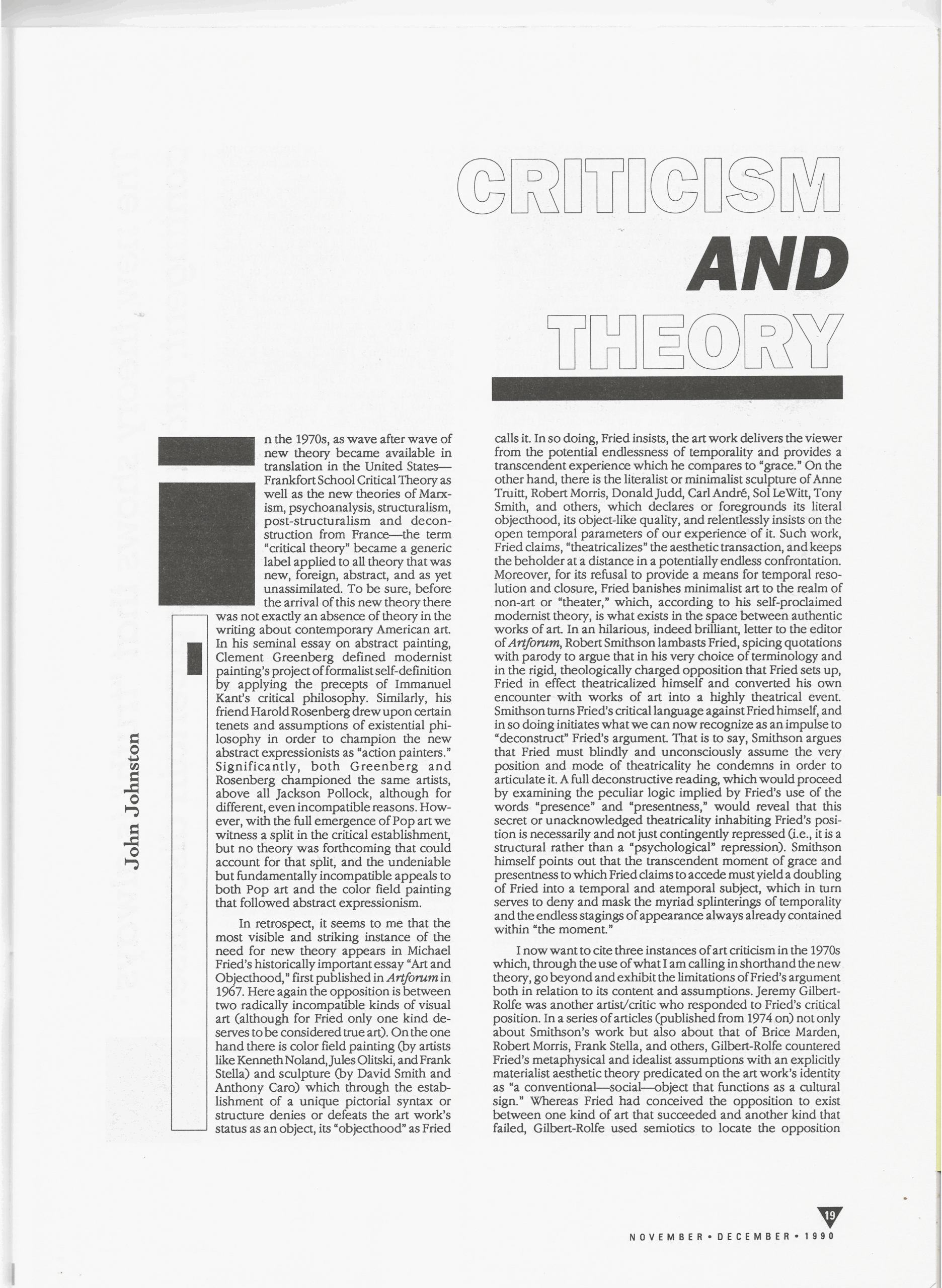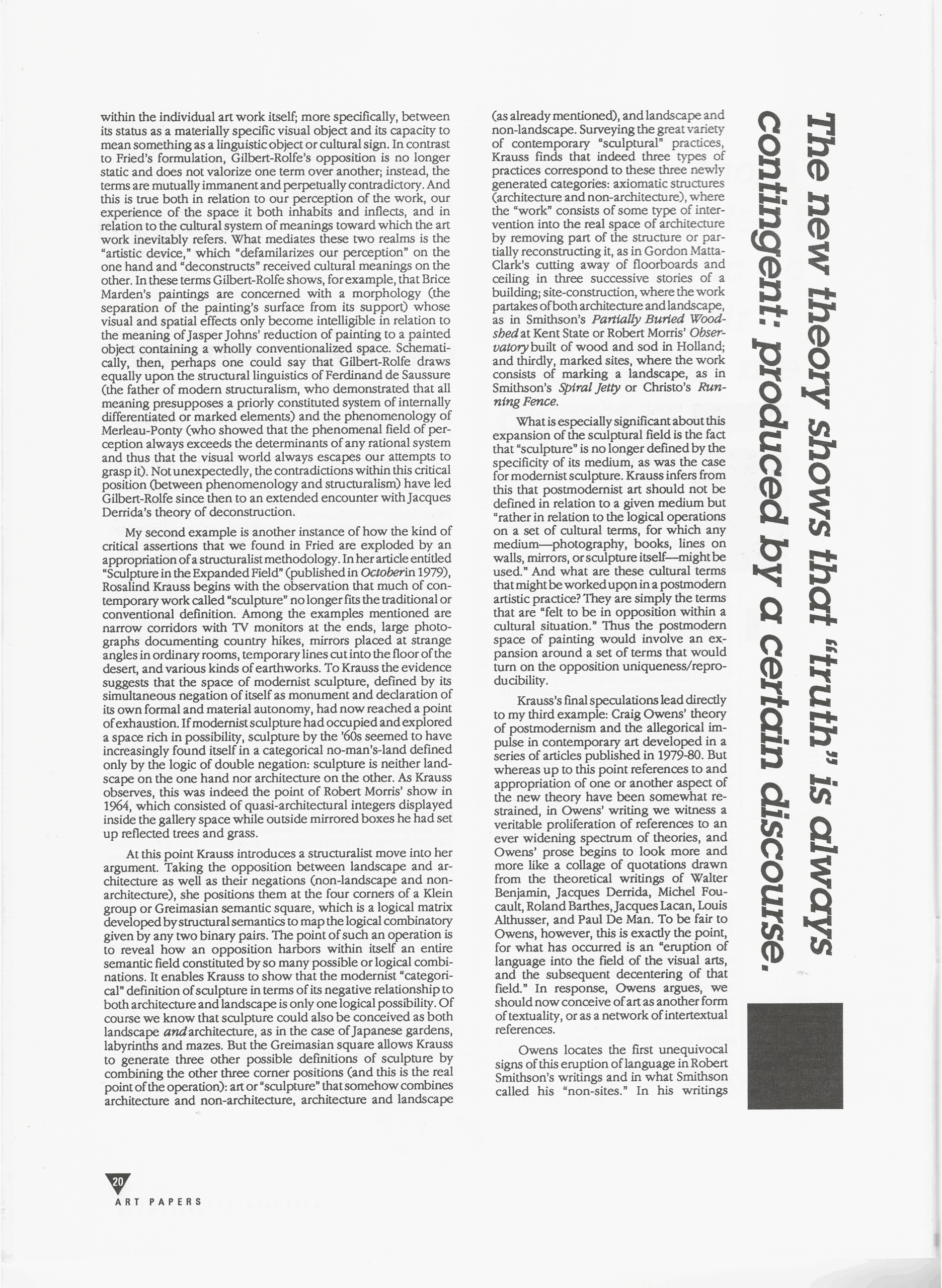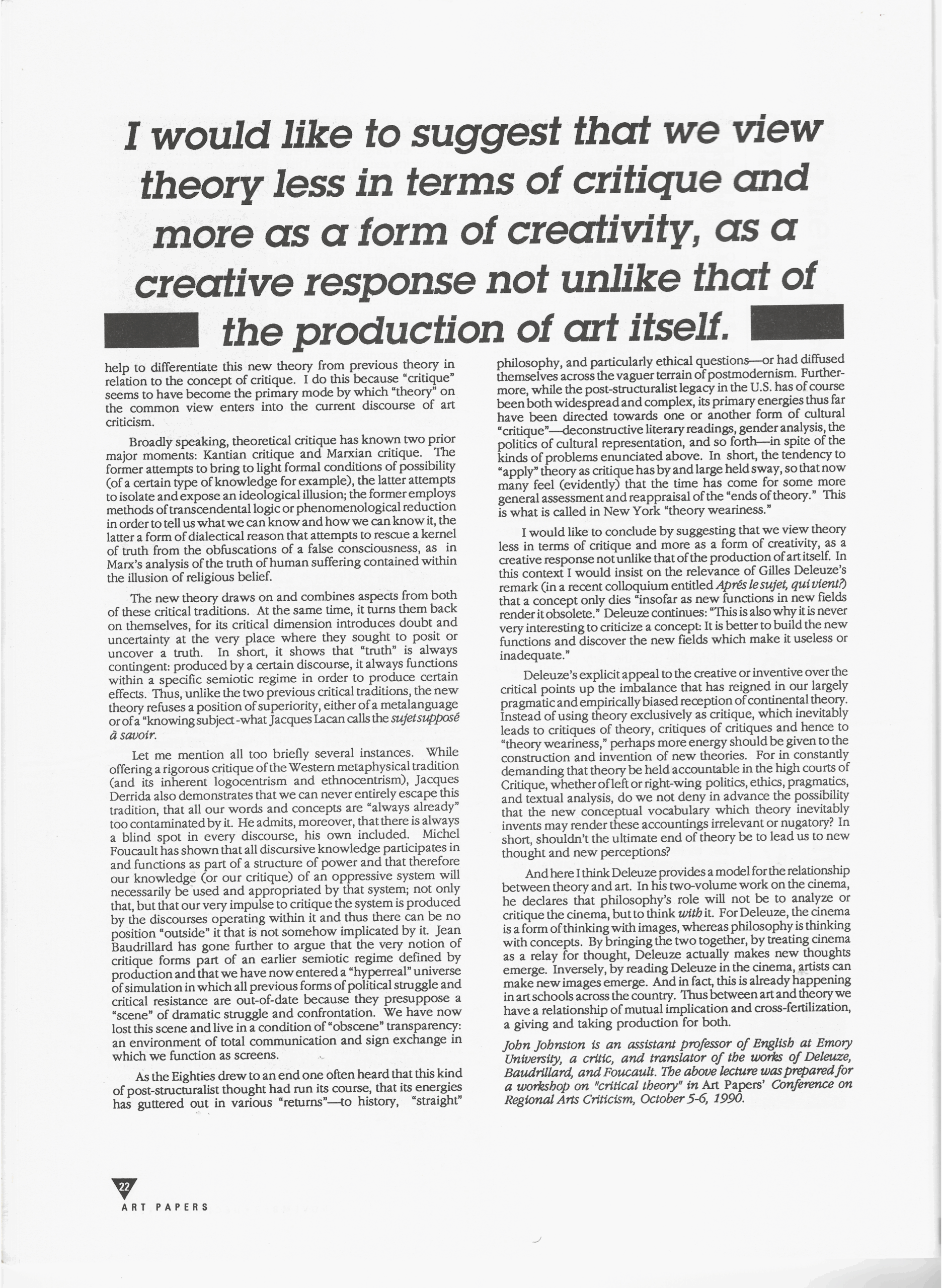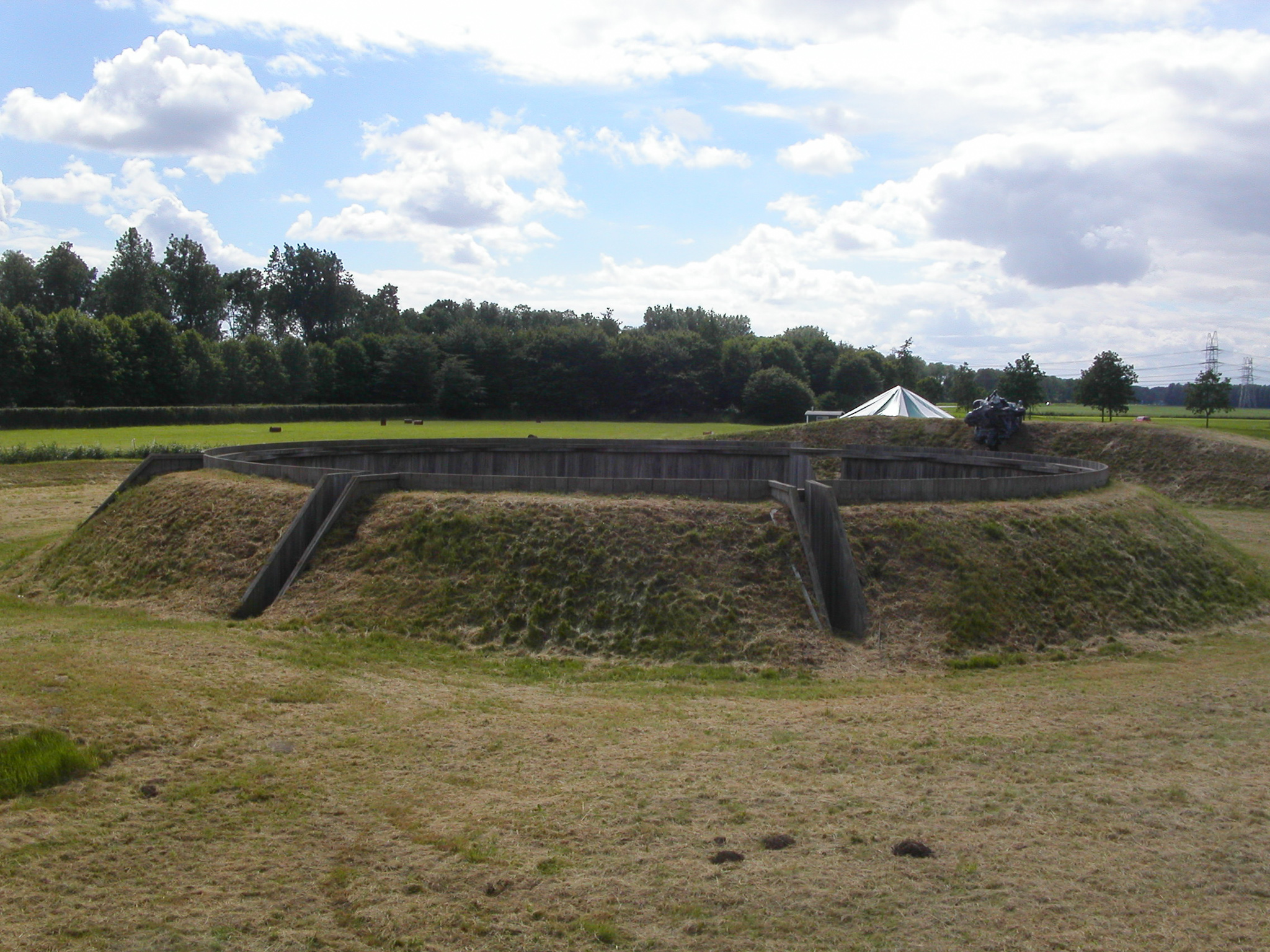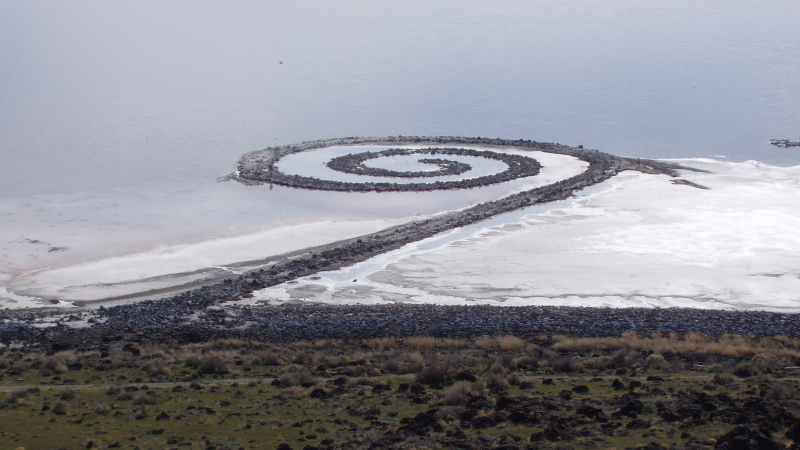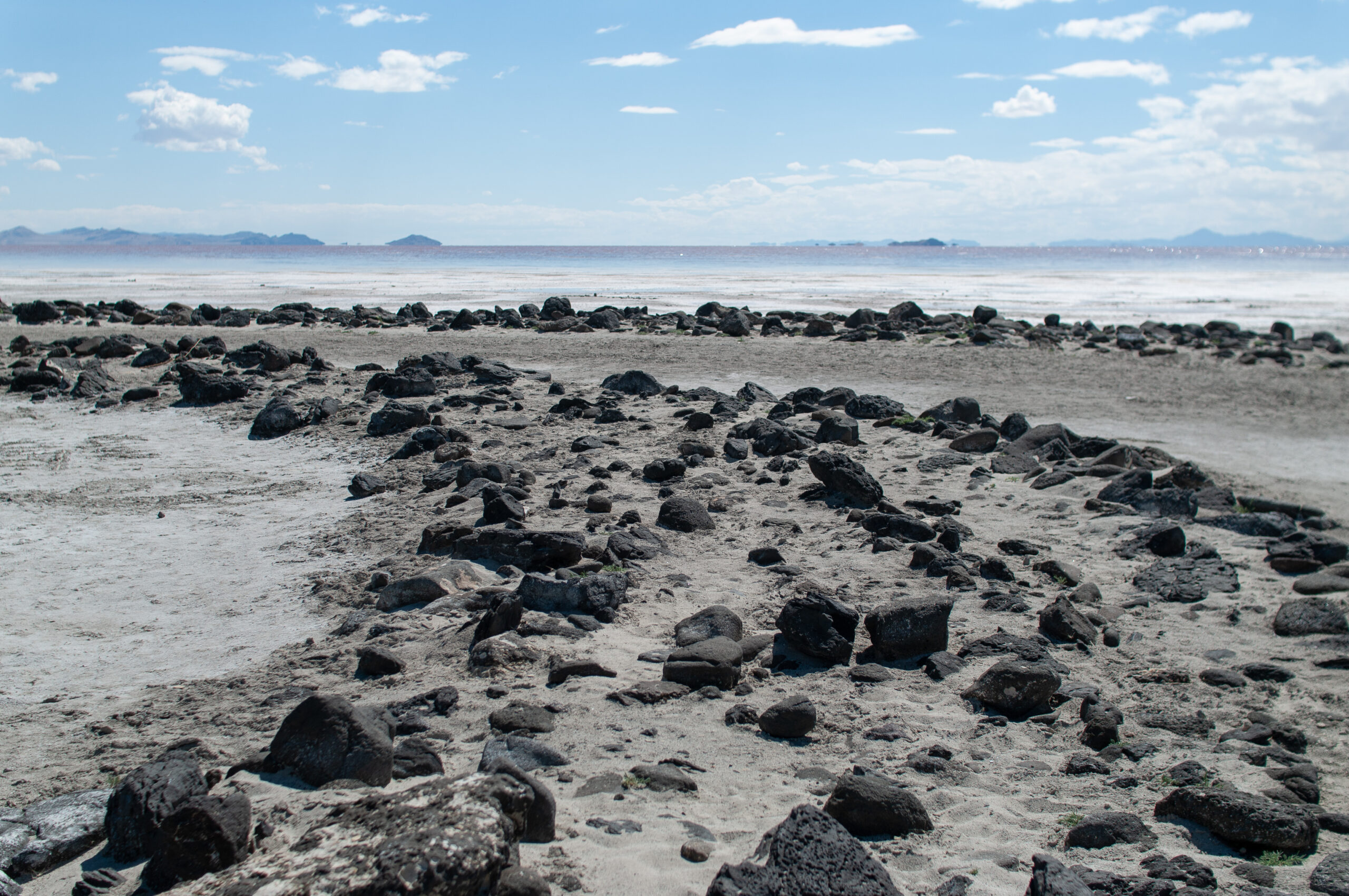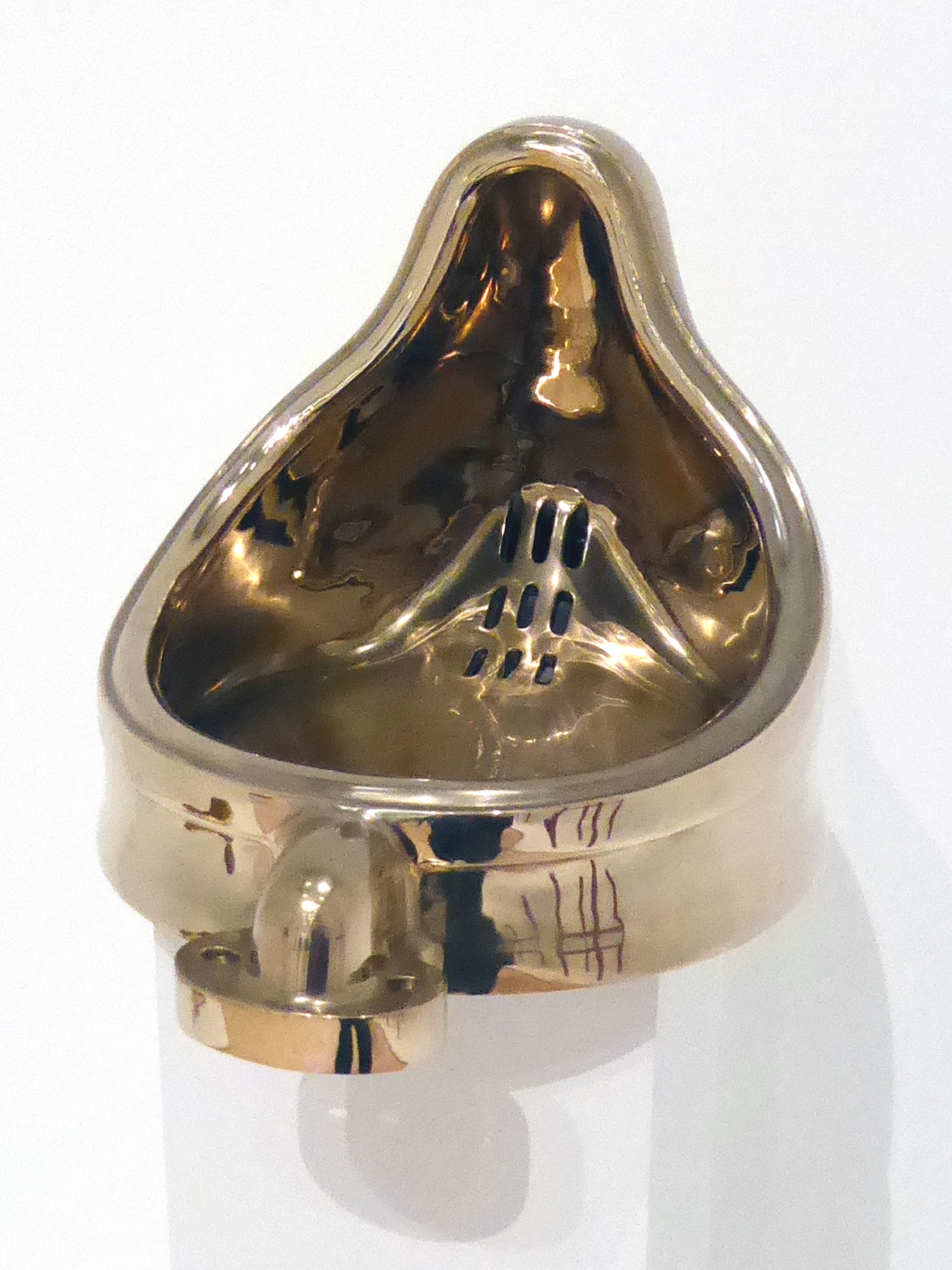Criticism and Theory
Robert Morris, The Observatory, 1971, installation view [courtesy of Wikimedia Commons]
Share:
This essay was originally published in ART PAPERS November/Decmber 1990, Vol 14, Issue 6.
In the 1970s, as wave after wave of new theory became available in translation in the United States—Frankfort School Critical Theory as well as the new theories of Marxism, psychoanalysis, structuralism, post-structuralism and deconstruction from France—the term “critical theory” became a generic label applied to all theory that was new, foreign, abstract, and as yet unassimilated. To be sure, before the arrival of this new theory there was not exactly an absence of theory in the writing about contemporary American art. In his seminal essay on abstract painting, Clement Greenberg defined modernist painting’s project of formalist self-definition by applying the precepts of Immanuel Kant’s critical philosophy. Similarly, his friend Harold Rosenberg drew upon certain tenets and assumptions of existential philosophy in order to champion the new abstract expressionists as “action painters.” Significantly, both Greenberg and Rosenberg championed the same artists, above all Jackson Pollock, although for different, even incompatible reasons. However, with the full emergence of Pop art we witness a split in the critical establishment, but no theory was forthcoming that could account for that split, and the undeniable but fundamentally incompatible appeals to both Pop art and the color field painting that followed abstract expressionism.
In retrospect, it seems to me that the most visible and striking instance of the need for new theory appears in Michael Fried’s historically important essay “Art and Objecthood,” first published in Artforum in 1967. Here again the opposition is between two radically incompatible kinds of visual art (although for Fried only one kind deserves to be considered true art). On the one hand there is color field painting (by artists like Kenneth Noland, Jules Olitski, and Frank Stella) and sculpture (by David Smith and Anthony Caro) which through the establishment of a unique pictorial syntax or structure denies or defeats the art work’s status as an object, its “objecthood” as Fried calls it. In so doing, Fried insists, the art work delivers the viewer from the potential endlessness of temporality and provides a transcendent experience which he compares to “grace.” On the other hand, there is the literalist or minimalist sculpture of Anne Truitt, Robert Morris, Donald Judd, Carl André, Sol LeWitt, Tony Smith, and others, which declares or foregrounds its literal objecthood, its object-like quality, and relentlessly insists on the open temporal parameters of our experience of it. Such work, Fried claims, “theatricalizes” the aesthetic transaction, and keeps the beholder at a distance in a potentially endless confrontation. Moreover, for its refusal to provide a means for temporal resolution and closure, Fried banishes minimalist art to the realm of non-art or “theater,” which, according to his self-proclaimed modernist theory, is what exists in the space between authentic works of art. In an hilarious, indeed brilliant, letter to the editor of Artforum, Robert Smithson lambasts Fried, spicing quotations with parody to argue that in his very choice of terminology and in the rigid, theologically charged opposition that Fried sets up, Fried in effect theatricalized himself and converted his own encounter with works of art into a highly theatrical event. Smithson turns Fried’s critical language against Fried himself, and in so doing initiates what we can now recognize as an impulse to “deconstruct” Fried’s argument. That is to say, Smithson argues that Fried must blindly and unconsciously assume the very position and mode of theatricality he condemns in order to articulate it. A full deconstructive reading, which would proceed by examining the peculiar logic implied by Fried’s use of the words “presence” and “presentness,” would reveal that this secret or unacknowledged theatricality inhabiting Fried’s position is necessarily and not just contingently repressed (i.e., it is a structural rather than a “psychological” repression). Smithson himself points out that the transcendent moment of grace and presentness to which Fried claims to accede must yield a doubling of Fried into a temporal and atemporal subject, which in turn serves to deny and mask the myriad splinterings of temporality and the endless stagings of appearance always already contained within “the moment.”
I now want to cite three instances of art criticism in the 1970s which, through the use of what I am calling in shorthand the new theory, go beyond and exhibit the limitations of Fried’s argument both in relation to its content and assumptions. Jeremy Gilbert- Rolfe was another artist/critic who responded to Fried’s critical position. In a series of articles (published from 1974 on) not only about Smithson’s work but also about that of Brice Marden, Robert Morris, Frank Stella, and others, Gilbert-Rolfe countered Fried’s metaphysical and idealist assumptions with an explicitly materialist aesthetic theory predicated on the art work’s identity as “a conventional-social-object that functions as a cultural sign.” Whereas Fried had conceived the opposition to exist between one kind of art that succeeded and another kind that failed, Gilbert-Rolfe used semiotics to locate the opposition within the individual art work itself; more specifically, between its status as a materially specific visual object and its capacity to mean something as a linguistic object or cultural sign. In contrast to Fried’s formulation, Gilbert-Rolfe’s opposition is no longer static and does not valorize one term over another; instead, the terms are mutually immanent and perpetually contradictory. And this is true both in relation to our perception of the work, our experience of the space it both inhabits and inflects, and in relation to the cultural system of meanings toward which the art work inevitably refers. What mediates these two realms is the “artistic device,” which “defamilarizes our perception” on the one hand and “deconstructs” received cultural meanings on the other. In these terms Gilbert-Rolfe shows, for example, that Brice Marden’s paintings are concerned with a morphology (the separation of the painting’s surface from its support) whose visual and spatial effects only become intelligible in relation to the meaning of Jasper Johns’ reduction of painting to a painted object containing a wholly conventionalized space. Schematically, then, perhaps one could say that Gilbert-Rolfe draws equally upon the structural linguistics of Ferdinand de Saussure (the father of modern structuralism, who demonstrated that all meaning presupposes a priorly constituted system of internally differentiated or marked elements) and the phenomenology of Merleau-Ponty (who showed that the phenomenal field of perception always exceeds the determinants of any rational system and thus that the visual world always escapes our attempts to grasp it). Not unexpectedly, the contradictions within this critical position (between phenomenology and structuralism) have led Gilbert-Rolfe since then to an extended encounter with Jacques Derrida’s theory of deconstruction.
My second example is another instance of how the kind of critical assertions that we found in Fried are exploded by an appropriation of a structuralist methodology. In her article entitled “Sculpture in the Expanded Field” (published in October in 1979), Rosalind Krauss begins with the observation that much of contemporary work called “sculpture” no longer fits the traditional or conventional definition. Among the examples mentioned are narrow corridors with TV monitors at the ends, large photographs documenting country hikes, mirrors placed at strange angles in ordinary rooms, temporary lines cut into the floor of the desert, and various kinds of earthworks. To Krauss the evidence suggests that the space of modernist sculpture, defined by its simultaneous negation of itself as monument and declaration of its own formal and material autonomy, had now reached a point of exhaustion. If modernist sculpture had occupied and explored a space rich in possibility, sculpture by the ’60s seemed to have increasingly found itself in a categorical no-man’s-land defined only by the logic of double negation: sculpture is neither landscape on the one hand nor architecture on the other. As Krauss observes, this was indeed the point of Robert Morris’ show in 1964, which consisted of quasi-architectural integers displayed inside the gallery space while outside mirrored boxes he had set up reflected trees and grass.
At this point Krauss introduces a structuralist move into her argument. Taking the opposition between landscape and architecture as well as their negations (non-landscape and non- architecture), she positions them at the four corners of a Klein group or Greimasian semantic square, which is a logical matrix developed by structural semantics to map the logical combinatory given by any two binary pairs. The point of such an operation is to reveal how an opposition harbors within itself an entire semantic field constituted by so many possible or logical combinations. It enables Krauss to show that the modernist “categorical” definition of sculpture in terms of its negative relationship to both architecture and landscape is only one logical possibility. Of course we know that sculpture could also be conceived as both landscape and architecture, as in the case of Japanese gardens, labyrinths and mazes. But the Greimasian square allows Krauss to generate three other possible definitions of sculpture by combining the other three corner positions (and this is the real point of the operation): art or “sculpture” that somehow combines architecture and non-architecture, architecture and landscape (as already mentioned), and landscape and non-landscape. Surveying the great variety of contemporary “sculptural” practices, Krauss finds that indeed three types of practices correspond to these three newly generated categories: axiomatic structures (architecture and non-architecture), where the “work” consists of some type of intervention into the real space of architecture by removing part of the structure or partially reconstructing it, as in Gordon Matta-Clark’s cutting away of floorboards and ceiling in three successive stories of a building; site-construction, where the work partakes of both architecture and landscape, as in Smithson’s Partially Buried Wood– shed at Kent State or Robert Morris’ Observatory built of wood and sod in Holland; and thirdly, marked sites, where the work consists of marking a landscape, as in Smithson’s Spiral Jetty or Christo’s Running Fence.
Robert Morris, The Observatory, 1971, installation view [courtesy of Wikimedia Commons]
What is especially significant about this expansion of the sculptural field is the fact that “sculpture” is no longer defined by the specificity of its medium, as was the case for modernist sculpture. Krauss infers from this that postmodernist art should not be defined in relation to a given medium but “rather in relation to the logical operations on a set of cultural terms, for which any medium—photography, books, lines on walls, mirrors, or sculpture itself—might be used.” And what are these cultural terms that might be worked upon in a postmodern artistic practice? They are simply the terms that are “felt to be in opposition within a cultural situation.” Thus the postmodern space of painting would involve an expansion around a set of terms that would turn on the opposition uniqueness/reproducibility.
Krauss’s final speculations lead directly to my third example: Craig Owens’ theory of postmodernism and the allegorical impulse in contemporary art developed in a series of articles published in 1979-80. But whereas up to this point references to and appropriation of one or another aspect of the new theory have been somewhat restrained, in Owens’ writing we witness a veritable proliferation of references to an ever widening spectrum of theories, and Owens’ prose begins to look more and more like a collage of quotations drawn from the theoretical writings of Walter Benjamin, Jacques Derrida, Michel Foucault, Roland Barthes, Jacques Lacan, Louis Althusser, and Paul De Man. To be fair to Owens, however, this is exactly the point, for what has occurred is an “eruption of language into the field of the visual arts, and the subsequent decentering of that field.” In response, Owens argues, we should now conceive of art as another form of textuality, or as a network of intertextual references.
Robert Smithson, Spiral Jetty, installation view from Rozel Point, 1970 [courtesy of Wikimedia Commons]
Robert Smithson, Spiral Jetty, installation detail, 1970 [courtesy of Wikimedia Commons]
Owens locates the first unequivocal signs of this eruption of language in Robert Smithson’s writings and in what Smithson called his “non-sites.” In his writings Smithson treats language not as a transparent vehicle for communication but as a linguistic substance with its own visual, labyrinthian qualities evident in its depths and stratifications, densities, abysses and discontinuities. “Language,” Smithson writes, has become “an infinite museum whose center is everywhere and whose limits are nowhere.” As a result of this concern with language—and I think this is Owens’ most important point—Smithson’s writings no longer function as a supplement to artworks to which they would serve as illuminations, explanations, or extensions—i.e., as artist’s statements–-but are themselves artistic texts. Similarly, the non-sites, which enact the same de-centering and displacement as does language, function textually, in the cross-referenced play of referrals and marks, presences and absences. More specifically, these non-sites are composed of photographs, maps, pieces of writing and material elements (usually rocks, stones, earth) removed from a particular locale and displayed in a gallery. They form, as Smithson himself declared, “networks of signs…discovered as you go along.” Smithson’s art, in sum, makes greatest sense as a transformation of the visual field into a textual one. And nowhere is this clearer than in the earthwork sculpture Spiral Jetty, where a re-arrangement of indigenous rocks becomes a graphic signifier inscribed on the surface of the Great Salt Lake. Owens describes how this “text” functions:
Like the non-site, the Jetty is not a discrete work, but one link in a chain of signifiers which summon and refer to one another in a dizzying spiral. For where else does the Jetty exist except in the film which Smithson made, the narrative he published, the photographs which accompany that narrative, and the various maps, diagrams, drawings, etc. he made about it? Unintelligible at close range, the spiral form of the Jetty is completely intuitable only from a distance, and that distance is most often achieved by imposing a text between viewer and work. Smithson thus accomplishes a radical dislocation of the notion of point-of-view, which is no longer a function of physical position, but of the mode (photographic, cinematic, textual) of confrontation with the work. The work is henceforth defined by the position it occupies in a potentially infinite chain extending from the site itself and the associations it provokes… to quotations of the work in other works.” As for Smithson’s declared intentions: “In the end I would let the site determine what I would build” he said, and it is no secret that one of those determinations was the Indian myth of an enormous whirlpool at the Lake’s center.
Sherrie Levine, Fountain (Buddha), 1996, bronze, 12 x 17 x 16 inches [courtesy of Wikimedia Commons]
That Smithson’s work internalizes allegorical procedures seems obvious enough. However, when Owens attempts to extend the concept of allegory in order to define an entire range of postmodern artistic practices, theoretical problems arise. Nevertheless, I think Owens is right to discuss the work of Robert Rauschenberg, Laurie Anderson, Robert Longo, Sherrie Levine, Cindy Sherman and the others in explicitly textual terms. That is, this work does not attempt to isolate the specific properties of a particular medium in order to exploit and intensify its expressive or signifying potential, as was the case in modernist art; instead, these artists create texts which function by commenting on other cultural texts or sign systems, usually drawing our attention to how these signifying systems constitute rather than reflect or communicate is pre-existent meanings and effects. Thus Cindy Sherman’s multiple self-portraits in cinema-like stills in which she costumes herself as a series of recognizable female stereotypes are to be read as investigating “specular models of femininity projected by the media to encourage imitation, identification” (Owens).
In a later article, Owens notes the convergence of much of this kind of postmodern art with explicitly feminist concerns. A striking example (not mentioned by Owens) is Mary Kelly’s Post- Partum Document, an elaborate multi-media documentation of the artist as mother’s first six years with her male child. This project, which extended from 1973 to 1979, was intended to explore certain assumptions about the relation between maternal femininity and the mother’s narcissistic identification with the child based on the psychoanalytic theory of Jacques Lacan, but these issues rapidly became indistinguishable from the exploration of social positioning and the constitution of subjectivity through the various discourses and representations that circulate through home and school. (Curiously, little attention was given to the effects of documenting these processes on the subjects under study–-Mary Kelly became a famous artist, but what was the effect on her child?).
By 1980, I think it’s fair to say, the new theory had become as important to artists making new art as it was to those writing about art. And this is not just true in highly visible cases like Peter Halley’s and the neo-geo artists’ appropriation of Foucault and Baudrillard. Artists, by definition, are quick to sense changes in the cultural climate and to make these changes visible in their art. The new theory proposes fundamentally new assumptions about human action, identity and the production of meaning. If before it had been possible to think of the artist, the artwork and the viewer or critic as discrete, free-standing or autonomous entities, the new theory dissolves and reweaves them into what we might call figures in a field of conflicting discourses. These figures are constituted by the interpretive frameworks and strategies, furthermore, are the only way we have of thinking, of knowing who we are or of having an identity or “self”; and similarly for the objects of our vision, which are pre-selected by these weavings of discourse. Not only the things we are given to see by the means by which our perception or attention is provoked and the ways in which we make sense out of them are always already articulated according to some pre-existing interpretive framework or system of differentiation. To make this process available for not only scrutiny but play and disruption, as so much contemporary art does, is necessarily a theoretical act.
At this point I would like to offer a few remarks which may help to differentiate this new theory from previous theory in relation to the concept of critique. I do this because “critique” seems to have become the primary mode by which “theory” on the common view enters into the current discourse of art criticism.
Broadly speaking, theoretical critique has known two prior major moments: Kantian critique and Marxian critique. The former attempts to bring to light formal conditions of possibility (of a certain type of knowledge for example), the latter attempts to isolate and expose an ideological illusion; the former employs methods of transcendental logic or phenomenological reduction in order to tell us what we can know and how we can know it, the latter a form of dialectical reason that attempts to rescue a kernel of truth from the obfuscations of a false consciousness, as in Marx’s analysis of the truth of human suffering contained within the illusion of religious belief.
The new theory draws on and combines aspects from both of these critical traditions. At the same time, it turns them back on themselves, for its critical dimension introduces doubt and uncertainty at the very place where they sought to posit or uncover a truth. In short, it shows that “truth” is always contingent: produced by a certain discourse, it always functions within a specific semiotic regime in order to produce certain effects. Thus, unlike the two previous critical traditions, the new theory refuses a position of superiority, either of a metalanguage or of a “knowing subject-what Jacques Lacan calls the sujet supposé à savoir.
Let me mention all too briefly several instances. While offering a rigorous critique of the Western metaphysical tradition (and its inherent logocentrism and ethnocentrism), Jacques Derrida also demonstrates that we can never entirely escape this tradition, that all our words and concepts are “always already” too contaminated by it. He admits, moreover, that there is always a blind spot in every discourse, his own included. Michel Foucault has shown that all discursive knowledge participates in and functions as part of a structure of power and that therefore our knowledge (or our critique) of an oppressive system will necessarily be used and appropriated by that system; not only that, but that our very impulse to critique the system is produced by the discourses operating within it and thus there can be no position “outside” it that is not somehow implicated by it. Jean Baudrillard has gone further to argue that the very notion of critique forms part of an earlier semiotic regime defined by production and that we have now entered a “hyperreal” universe of simulation in which all previous forms of political struggle and critical resistance are out-of-date because they presuppose a “scene” of dramatic struggle and confrontation. We have now lost this scene and live in a condition of “obscene” transparency: an environment of total communication and sign exchange in which we function as screens.
As the Eighties drew to an end one often heard that this kind of post-structuralist thought had run its course, that its energies has guttered out in various “returns”—to history, “straight” philosophy, and particularly ethical questions—or had diffused themselves across the vaguer terrain of postmodernism. Furthermore, while the post-structuralist legacy in the U.S. has of course been both widespread and complex, its primary energies thus far have been directed towards one or another form of cultural “critique”—deconstructive literary readings, gender analysis, the politics of cultural representation, and so forth—in spite of the kinds of problems enunciated above. In short, the tendency to “apply” theory as critique has by and large held sway, so that now many feel (evidently) that the time has come for some more general assessment and reappraisal of the “ends of theory.” This is what is called in New York “theory weariness.”
I would like to conclude by suggesting that we view theory less in terms of critique and more as a form of creativity, as a creative response not unlike that of the production of art itself. In this context I would insist on the relevance of Gilles Deleuze’s remark (in a recent colloquium entitled Aprés le sujet, qui vient?) that a concept only dies “insofar as new functions in new fields render it obsolete.” Deleuze continues: “This is also why it is never very interesting to criticize a concept: It is better to build the new functions and discover the new fields which make it useless or inadequate.”
Deleuze’s explicit appeal to the creative or inventive over the critical points up the imbalance that has reigned in our largely pragmatic and empirically biased reception of continental theory. Instead of using theory exclusively as critique, which inevitably leads to critiques of theory, critiques of critiques and hence to “theory weariness,” perhaps more energy should be given to the construction and invention of new theories. For in constantly demanding that theory be held accountable in the high courts of Critique, whether of left or right-wing politics, ethics, pragmatics, and textual analysis, do we not deny in advance the possibility that the new conceptual vocabulary which theory inevitably invents may render these accountings irrelevant or nugatory? In short, shouldn’t the ultimate end of theory be to lead us to new thought and new perceptions?
And here I think Deleuze provides a model for the relationship between theory and art. In his two-volume work on the cinema, he declares that philosophy’s role will not be to analyze or critique the cinema, but to think with it. For Deleuze, the cinema is a form of thinking with images, whereas philosophy is thinking with concepts. By bringing the two together, by treating cinema as a relay for thought, Deleuze actually makes new thoughts emerge. Inversely, by reading Deleuze in the cinema, artists can make new images emerge. And in fact, this is already happening in art schools across the country. Thus between art and theory we have a relationship of mutual implication and cross-fertilization, a giving and taking production for both.
John Johnston was an assistant professor of English at Emory University, a critic, and translator of the works of Deleuze, Baudrillard, and Foucault. The above lecture was prepared for a workshop on “critical theory” in Art Papers’ Conference on Regional Arts Criticism, October 5-6, 1990.

